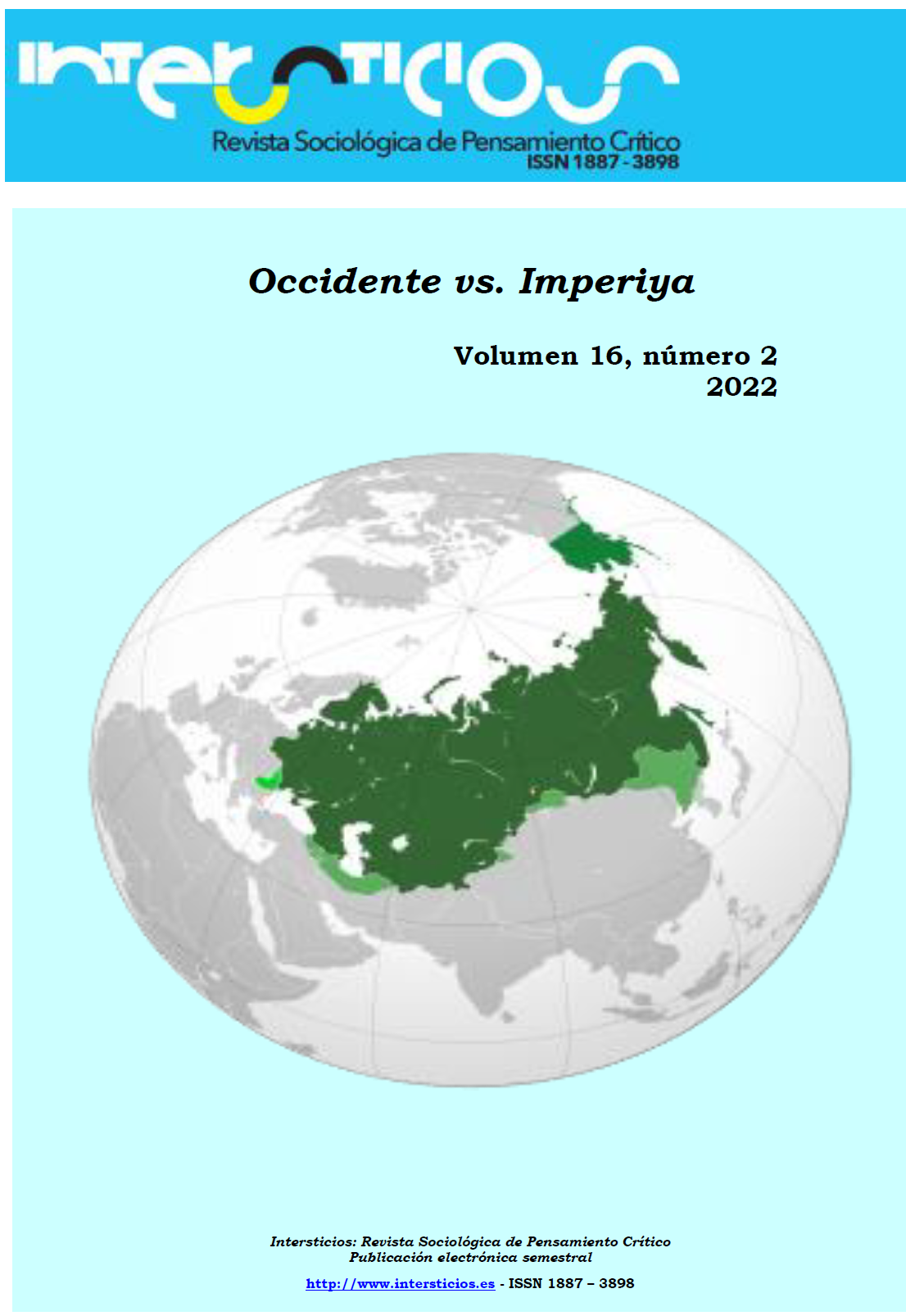Sociology and Psychology. Mental Health in big Cities
Keywords:
Simmel, City, Schizophrenia, Psychology, PsychiatryAbstract
This article compares Georg Simmel's ideas about the psychological impact of life in the "big modern city" with scientific research demonstrating the synergy between urban life and schizophrenia. For this, a quantitative study has been carried out of the works where Simmel talks about this issue, as well as of the different research works carried out from Psychology and Psychiatry. Although the Simmelian terminology differs notably from the scientific terminology, we find that the Simmelian approach indeed finds proof of scientific validity in the cited investigations. This work highlights the importance and timeliness of the Simmelian approach for the interdisciplinary analysis of urban environments.
References
Allardyce, J. y Boydell, J. (2006). Review: The Wider Social Environment and Schizophrenia. Schizophrenia Bulletin, 32: 592–598. https://doi.org/10.1093/schbul/sbl008
Canadell, Á. y Vicens, J. (2010). Habitar la ciudad. Miraguano: Madrid.
Caracci, G. (2008). General concepts of the relationship between urban areas and mental health. Current Opinions in Psychiatry, 21: 385–390. https://doi.org/10.1097/YCO.0b013e328303e198
García-González, M.C. (et al.) (2022). Prevención en salud desde el diseño del espacio público. El proyecto URB_HealthS como experiencia de transferencia de conocimiento. Ciudades, 25: 59-78. https://doi.org/10.24197/ciudades.25.2022.59-78
Faris, R. y Dunham, W. (1939). Mental disorders in urban areas: an ecological study of schizophrenia and other psychoses. Chicago: University of Chicago Press.
Frisby, D. (1992). Fragmentos de la modernidad. Teorías de la modernidad en la obra de Simmel, Kracauer y Benjamin. Madrid: La balsa de la Medusa.
Hill, A.B. (1965). The environment and disease: association or causation? Journal of the Royal Society of Medicine, 58: 295-300. https://doi.org/10.1353/obs.2020.0000
Hollingshead, A. y Redlich, F. (1958). Social class and mental illness. New York: John Wiley and Sons.
Ingenschay, D. (2009). El Berlín de Ayala. Cuadernos de filología alemana 1: 203-2016. https://doi.org/1133-0406
Jankélévitch, V. (2007). Georg Simmel: filósofo de la vida. Gedisa: Barcelona.
Kaplan, R. y Kaplan, S. (1989). The experience of nature: A psychological perspective. New York: Cambridge University Press
Krabbendam, L. y Van Os, J. (2005). Schizophrenia and Urbanicity: A Major Environmental Influence-Conditional on Genetic Risk. Schizophrenia Bulletin, 31: 795–799. https://doi.org/10.1093/schbul/sbi060
Lefèbvre, H. (1977). Sociología urbana. Problema actual del Estado. En Centro de Estudios de Urbanismo de Navarra Víctor Eusa. Colegio de Arquitectos Vasco-Navarro Delegación en Navarra. I Curso de Urbanismo, Sociología Urbana.
Lefèbvre, H. (2017). El derecho a la ciudad. Madrid: Capitán Swing.
Marcelis, M. (et al.) (1998). Urbanization and psychosis: a study of 1942-1978 birth cohorts in The Netherlands. Psychological Medicine, 28: 871-879. https://doi.org/10.1017/s0033291798006898
Mundo, D. (2016). Simmel reloaded. En E. Vernik y H. Borisonik (eds.). Georg Simmel, un siglo después. Buenos Aires: CLACSO.
Niño Murcia, C. (2008). Modos de vivir, formas de construir, modos de ser. En Navarrete, R. y Amaral, D. (eds.). XXI Bienal Colombiana de Arquitectura. Bogotá: Panamericana, pp. 29-35.
Peen, J. y Dekker, J. (2003). Urbanisation as a risk indicator for psychiatric admission. Soc Psychiatry Psychiatr Epidemiol, 38: 535–538. https://doi.org/10.1007/s00127-003-0671-y
Pérez-Álvarez, M. (2012). Esquizofrenia y cultura moderna: razones de la locura. Psicothema, 24: 1-9. https://doi.org/1886-144X
Sennett, R. (2019). Construir y habitar. Ética para la ciudad. Barcelona: Anagrama.
Simmel, G. (1977). Las grandes ciudades y la vida intelectual. En R. Gutiérrez Girardot (ed.). Discusión. Teorías sobre los sistemas sociales. Barcelona: Barral.
Spauwen, J. (et al.) (2006). Evidence that the outcome of developmental expression of psychosis is worse for adolescents growing up in an urban environment. Psychological Medicine, 36: 407–415. https://doi.org/10.1017/S0033291705006902
Streit, F. (et al.) (2014). A functional variant in the neuropeptide S receptor 1 gene moderates the influence of urban upbringing on stress processing in the amygdale. Stress, 17: 352-361. https://doi.org/10.3109/10253890.2014.921903
Sundquist, K,, Frank, G. y Sundquist, J. (2004). Urbanisation and incidence of psychosis and depression. British Journal of Psychiatry, 184: 293-298. https://doi.org/10.1192/bjp.184.4.293
Tizón, J.L. (2006). Salud mental, ciudades y urbanismo: 1. Sobre psicosomática y psicodinámica de la vida urbana. Rev. Asoc. Esp. Neuropsiq [en línea] 26: 9-29. http://scielo.isciii.es/scielo.php?script=sci_arttext&pid=S0211-57352006000100002&lng=es&nrm=iso, último acceso 27/06/2022
Van Os, J. (2003). Do Urbanicity and Familial Liability Coparticipate in Causing Psychosis? Am J Psychiatry, 160: 477–482. https://doi.org/10.1176/appi.ajp.160.3.477
Van Os, J. (2004). Does the urban environment cause psychosis? British Journal of Psychiatry, 184: 287-288. https://doi.org/10.1192/bjp.184.4.287
Van Os, J., Pedersen, C. y Mortensen, P. (2004). Confirmation of Synergy Between Urbanicity and Familial Liability in the Causation of Psychosis. Am J Psychiatry, 161: 2312–2314. https://doi.org/10.1176/appi.ajp.161.12.2312
Vartanian, O. (et al.) (2013). Impact of contour on aesthetic judgments and approach-avoidance decisions in architecture. Proc Natl Acad Sci, 110: 10446-10453. https://doi.org/10.1073/pnas.1301227110
Wieser, M. (et al.) (2007). Social and cognitive functioning, urbanicity and risk for schizophrenia. British Journal of Psychiatry, 191: 320-324. https://doi.org/10.1192/bjp.bp.106.031328









